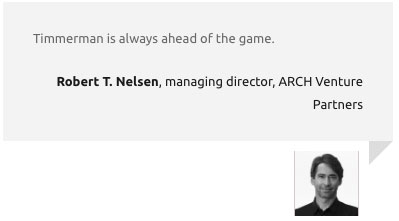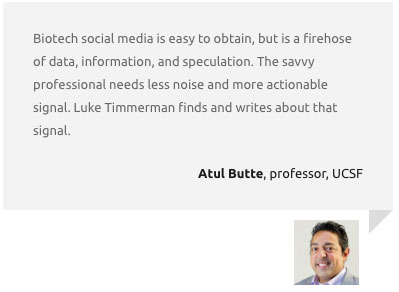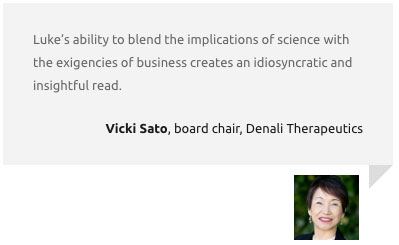Looking Back and Seeing The Future: The Relationships that Propel Biotech
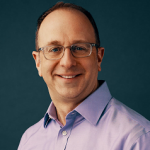
Sam Blackman, MD, PhD; entrepreneur-in-residence, GV
It’s been a rough week (again) for those of us within the biotech ecosystem. Actually, it’s been a rough month. Hell, let’s just say it’s been a hard year. Or two.
Rather than writing about the negatives – there will be plenty of time for that, I suspect – I’d like to share a delightful little story.
I recently returned from a meeting on pediatric sarcomas held at Cold Spring Harbor Laboratory. I’ve never been before, and it was hard to not be awed by the campus and the sense of legacy you have in the buildings and on the grounds and by the innumerable photographic reminders of the role that CSHL has played, as a physical place, in the history of molecular biology and biotechnology.
Not only was the physical place inspiring, and so were the people at the conference. I felt fortunate to refresh long-standing connections that included Alejandro Sweet-Cordero and Kim Stegmaier. Both were young faculty members in the Pediatric Hematology/Oncology division at Dana-Farber back when I was but a wee fellow.
The combination of photographic history and personal re-connections was a reminder that one of the enduring joys provided by a life in science and medicine are the career-spanning, or sometimes life-spanning, relationships that you can build. It is this joy that will make so many of us flock to Chicago this year (twice!) for AACR and ASCO.
Returning to my home on Orcas Island after the CSHL meeting, I got back to one of the more mundane tasks that I’ve been tackling during my recent “retirement” from Day One Biopharmaceuticals – cleaning out the storage room. Absolute joy and delight came from cleaning out an old filing cabinet.
There was a dusty drawer full of papers and certificates, many dating back to my medical and graduate school years (mid-1990s), and some dating back to my undergraduate years. I found a photocopy of the first journal article I co-authored, a stack of old student and hospital IDs from medical school (which serve only to remind me that I somehow managed to transform hair follicle stem cells into adipose-derived stem cells over the past 30 years), letters of recommendations from former college professors, and other ephemera that reminded me of exactly how long I’ve been a denizen of the medical and scientific ecosystem.
One surprising treasure was a program booklet from the 1998 MD/PhD National Student Conference. That year I was midway through my MD/PhD program at the University of Illinois Chicago and was lucky to have somehow managed to have my abstract selected for this conference, which was held every year, hosted by the University of Colorado Health Sciences Center (the conference is still ongoing and is in its 40th year this year).
The 1998 conference featured lectures by Carol Greider, Michael Welsh, Richard Klausner, Mark Groudine, and Michael Brown. In addition to hearing 5 incredible keynote talks, I remember that a number of us went mountain biking with Carol Greider. Looking back it was quite a reminder that I had the privilege of sharing a few days with a current Nobel Laureate, a future Nobel Laureate, a future NCI director, and multiple National Academy of Medicine members.
Perusing the list of attendees, I realized that for those 3 days in Aspen, not only was I sitting in the same room with then current luminaries, but many of the young scientists at that meeting ended up becoming highly accomplished future colleagues.
It turns out that I was sitting in the same room with Mike Thompson, MD, PhD, FASCO, who I’ve gotten to know through the years (on Twitter and in real life), Shannon Morris, who I would end up working together with in oncology clinical development at GSK, with James LaBelle, who I’d get to know and befriend as fellow fellows in pediatric oncology at Dana-Farber Cancer Institute, David Berman, who I would meet and interview in 2007 when he was at BMS, and who would be the person who inspired me to go into a career in drug development, and, most amazingly, Jeremy Bender, who would in 2020 become my CEO, my dear friend and partner, and with whom I would continue to build Day One Biopharmaceuticals into the success that it has become.
This week, my “retirement” is coming – unsurprisingly – to a premature end, as I am in Cambridge to begin the next chapter of my career as an entrepreneur-in-residence at GV. The time for looking back has concluded, and now it’s time to again look forward. But the past and future remain inextricably linked.
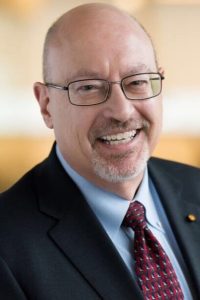
Robert Copeland
Much to my delight, and in keeping with the theme, I learned that Robert Copeland has also recently joined GV as an advisor. He and I are being reunited as colleagues. Many of you will know Bob from his innumerable scientific accomplishments, including the discovery and development of the first approved EZH2 inhibitor tazemetostat. But I have the privilege of also knowing Bob first as my biochemistry professor at the University of Chicago back in 1991 when he co-taught a course with the legendary Herbert Friedmann. And while I don’t remember the specifics from 30-plus years ago, I suspect that my introduction to the lac operon and the fundamental concepts of molecular biology came to me first via Bob Copeland.
Once again, Shakespeare was right: what’s past is prologue (a statement that is, ironically, inscribed on a statue found at the National Archives building in Washington, D.C. and an important reminder for all of us, today).
As Gary Gilliland, an incredible physician-scientist and my former department head at Merck, told me in my last meeting with him before I left to take new job, “Remember, Sam, it’s a long dance.”
Gary was, of course, absolutely correct.
We occupy an incredibly small world, and an even smaller one for those of us lucky to have a career in science and medicine and biopharmaceutical R&D. Our future is, of course, profoundly influenced by those who teach, train, and collaborate with us over the years. But unlike so many other fields, the long, if not epic, arcs of science and medicine all but guarantee that we accumulate a lifetime of colleagues, as well as colleagues for life.
In a world that is so fractured, I feel the need to cling even more tightly to the threads that connect people across space and time, like the ones tucked away in that filing cabinet drawer. Especially the threads that connect the remarkable people in our biotech community — people who have dedicated themselves to the pursuit of truth and the insatiable desire to positively impact human health.
I save them and treasure the threads that connect us much like I treasure those old papers and pictures, knowing that it is the connections that will sustain and hold us together, admixing and sometimes reconnecting us at unexpected points, so we can continue working together towards the greater good.

